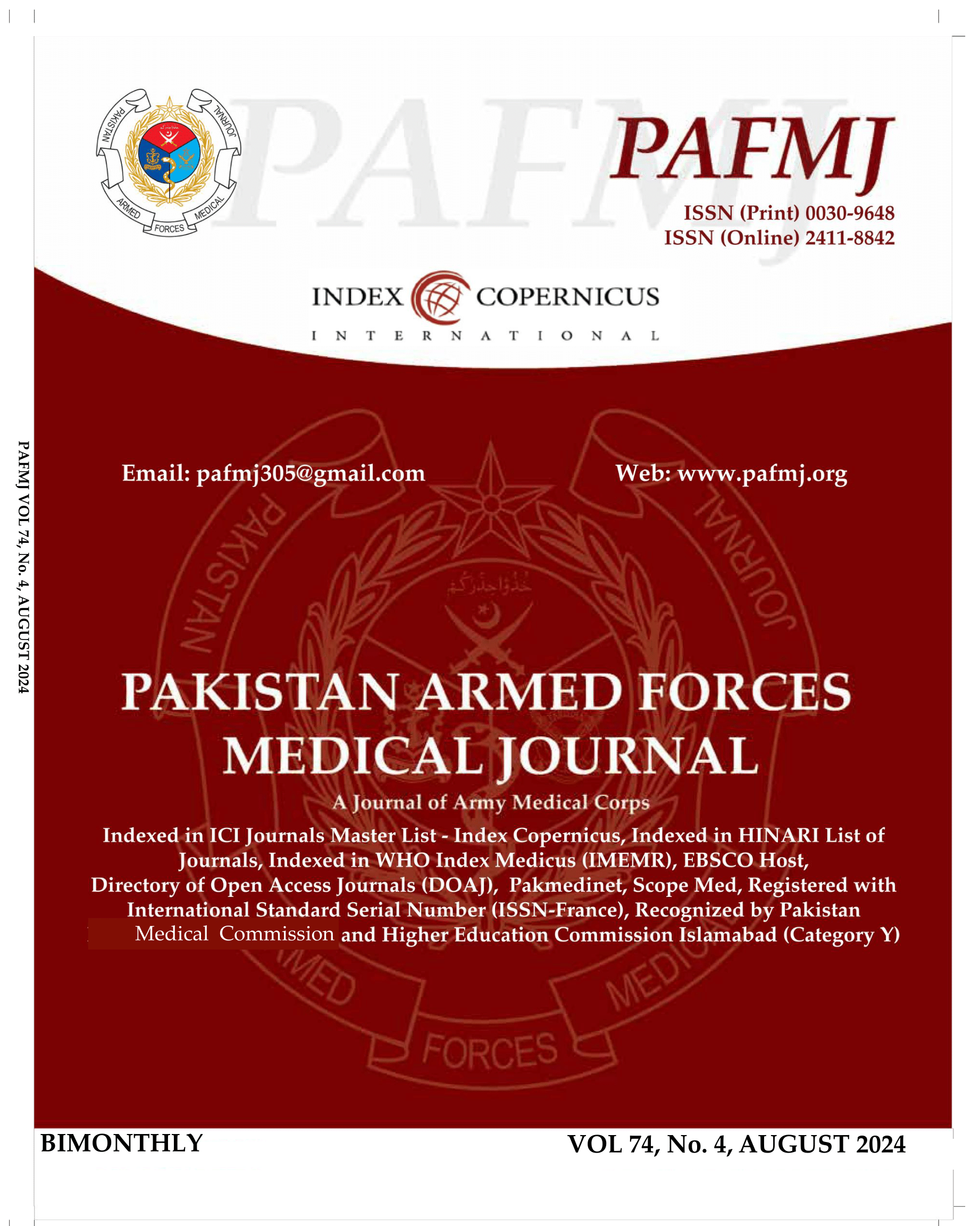Comparison of Post–Operative Hydrothorax in Supra 12th Rib Versus Infra 12th Rib Access in Prone Mini Percutaneous Nephrolithotomy
DOI:
https://doi.org/10.51253/pafmj.v74i4.10796Keywords:
Hydrothorax, Infra 12th rib percuteous nephrolithotomy, Supra 12th rib percuteous nephrolithotomy.Abstract
Objective: To determine the risk of post-operative hydrothorax in supra-12th rib versus infra-12th rib access in prone Mini Percutaneous Nephrolithotomy.
Study Design: Quasi-experimental study.
Place and Duration of Study: Armed Forces Institutes of Urology, Rawalpindi Pakistan from Jun to Dec 2022.
Methodology: In our study, 110 patients underwent assessment for indication of Percutaneous Nephrolithotomy, level of access, anatomy, site of puncture, incidence of hydrothorax, and requirement of closed-tube thoracostomy.
Results: Of the 110 patients who underwent prone Percutaneous Nephrolithotomy, 55(50%) patients underwent infra 12th rib tract approach (Group-1), and the rest, 55(50%) underwent supra 12th rib tract approach (Group-2) depending upon the location of stones, anatomy of pelvicalyceal system and stone burden. Overall, 10(9.09%) patients developed post- Percutaneous Nephrolithotomy Hydrothorax; out of these ten patients, 8(14.5%) patients were approached from the supra 12th rib tract and the remaining 2(3.6%) patients were approached from the infra 12th rib tract (p-value=0.047).
Conclusion: The study concludes that in prone Percutaneous Nephrolithotomy, infra-12th rib tract renal access is safer than supra-12th rib renal access regarding chest complications (Hydrothorax).
Downloads
References
Viljoen A, Chaudhry R. Renal stones Ann Clin Biochem 2019 ; 56(1): 15-27. https://doi.org/10.1177/0004563218781672
Hoffman A, Braun MM, Khayat M. Kidney Disease: Kidney Stones. FP Essent 2021; 509: 33-38.
Desai JD. Ultra-mini PNL (UMP): Material, indications, technique, advantages and results. Arch Esp Urol 2017; 70(1): 196201.
Lee JY, Jeh SU, Kim MD, Kang DH, Kwon JK, Ham WS, et al. Intraoperative and postoperative feasibility and safety of total tubeless, tubeless, small-bore tube, and standard percutaneous nephrolithotomy: a systematic review and network meta-analysis of 16 randomized controlled trials. BMC Urol 2017 ; 17(1): 48. https://doi.org/10.1186/s12894-017-0239-x
Yan MY, Lin J, Chiang HC, Chen YL, Chen PH. Supra-costal tubeless percutaneous nephrolithotomy is not associated with increased complication rate: a prospective study of safety and efficacy of supra-costal versus sub-costal access. BMC Urol 2018; 18(1): 112. https://doi.org/10.1186/s12894-018-0429-1
Güzel A, Oksay T, Ozturk SA, Soyupek AS, Ozorak A, Kosar A. Costovertebral angle as a novel tool for predicting the thoracic complication risk following percutaneous nephrolithotomy requiring supracostal access. Can Urol Assoc J 2021 ; 15(11): E608-E613. https://doi.org/10.5489/cuaj.7114
He Z, Tang F, Lu Z, He Y, Wei G, Zhong F, et al. Comparison of Supracostal and Infracostal Access For Percutaneous Nephrolithotomy: A Systematic Review and Meta-Analysis. Urol J 2019; 16(2): 107-114.
https://doi.org/10.22037/uj.v0i0.4727
Lojanapiwat B, Prasopsuk S. Upper-pole access for percutaneous nephrolithotomy: comparison of supracostal and infracostal approaches. J Endourol 2006; 20(7): 491-494.
https://doi.org/10.1089/end.2006.20.491
Palnizky G, Halachmi S, Barak M. Pulmonary Complications following Percutaneous Nephrolithotomy: A Prospective Study. Curr Urol 2013 ; 7(3): 113-116.
https://doi.org/10.1159/000356260
Chung DY, Kang DH, Cho KS, Jeong WS, Jung HD, Kwon JK, et al. Comparison of stone-free rates following shock wave lithotripsy, percutaneous nephrolithotomy, and retrograde intrarenal surgery for treatment of renal stones: A systematic review and network meta-analysis. PLoS One 2019 ; 14(2): e0211316. https://doi.org/10.1371/journal.pone.0211316
Bai Y, Tang Y, Deng L, Wang X, Yang Y, Wang J, et al. Management of large renal stones: laparoscopic pyelolithotomy versus percutaneous nephrolithotomy. BMC Urol 2017; 17(1): 75. https://doi.org/10.1186/s12894-017-0266-7
Lee JY, Jeh SU, Kim MD, Kang DH, Kwon JK, Ham WS, et al. Intraoperative and postoperative feasibility and safety of total tubeless, tubeless, small-bore tube, and standard percutaneous nephrolithotomy: a systematic review and network meta-analysis of 16 randomized controlled trials. BMC Urol 2017; 17(1): 48. https://doi.org/10.1186/s12894-017-0239-x
Taylor E, Miller J, Chi T, Stoller ML. Complications associated with percutaneous nephrolithotomy. Transl Androl Urol 2012 ; 1(4): 223-228.
https://doi.org/10.3978/j.issn.2223-4683.2012.12.01.
Sourial MW, Francois N, Box GN, Knudsen BE. Supracostal access tubeless percutaneous nephrolithotomy: minimizing complications. World J Urol 2019; 37(7): 1429-1433.
https://doi.org/10.1007/s00345-018-2518-x
Kunwar AK, Upadhyaya AM, Tiwari K, Shrestha SB, Yadav CS, Dangol B, et al. Thoracic Complications in Supracostal Percutaneous Nephrolithotomy. J Nepal Health Res Counc 2022 ; 20(2): 361-365. https://doi.org/10.33314/jnhrc.v20i02.3950
Treewattanakul C, Kittirattakarn P, Chongruksut W and Lojanapiwat B. Factors Predicting Pleural Complication Following Upper Pole Access Percutaneous Nephrolithotomy. Int Arch Urol Complic 2016; 2 (2): 017.
https://doi.org/10.23937/2469-5742/1510017
Kunwar AK, Upadhyaya AM, Tiwari K, Shrestha SB, Yadav CS, Dangol B. Thoracic Complications in Supracostal Percutaneous Nephrolithotomy. J Nepal Health Res Coun 2022; 20(02): 361-365. https://doi.org/10.33314/jnhrc.v20i02.3950
Güzel A, Oksay T, Ozturk SA, Soyupek AS, Ozorak A, Kosar A. Costovertebral angle as a novel tool for predicting the thoracic complication risk following percutaneous nephrolithotomy requiring supracostal access. Can Urol Assoc J 2021 ; 15(11): E608-E613. https://doi.org/10.5489/cuaj.7114
Downloads
Published
Issue
Section
License
Copyright (c) 2024 Sajjad Khan, Sohail Raziq, Waqas Ahmed Ranjha, Aamer Nadeem, Mujhaid Ali Khoso, Huma Asad

This work is licensed under a Creative Commons Attribution-NonCommercial 4.0 International License.















